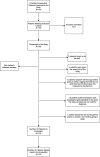Accuracy and usability of AcuPebble SA100 for automated diagnosis of obstructive sleep apnoea in the home environment setting: an evaluation study
- PMID: 34933855
- PMCID: PMC8693096
- DOI: 10.1136/bmjopen-2020-046803
Accuracy and usability of AcuPebble SA100 for automated diagnosis of obstructive sleep apnoea in the home environment setting: an evaluation study
Abstract
Objectives: Obstructive sleep apnoea (OSA) is a heavily underdiagnosed condition, which can lead to significant multimorbidity. Underdiagnosis is often secondary to limitations in existing diagnostic methods. We conducted a diagnostic accuracy and usability study, to evaluate the efficacy of a novel, low-cost, small, wearable medical device, AcuPebble_SA100, for automated diagnosis of OSA in the home environment.
Settings: Patients were recruited to a standard OSA diagnostic pathway in an UK hospital. They were trained on the use of type-III-cardiorespiratory polygraphy, which they took to use at home. They were also given AcuPebble_SA100; but they were not trained on how to use it.
Participants: 182 consecutive patients had been referred for OSA diagnosis in which 150 successfully completed the study.
Primary outcome measures: Efficacy of AcuPebble_SA100 for automated diagnosis of moderate-severe-OSA against cardiorespiratory polygraphy (sensitivity/specificity/likelihood ratios/predictive values) and validation of usability by patients themselves in their home environment.
Results: After returning the systems, two expert clinicians, blinded to AcuPebble_SA100's output, manually scored the cardiorespiratory polygraphy signals to reach a diagnosis. AcuPebble_SA100 generated automated diagnosis corresponding to four, typically followed, diagnostic criteria: Apnoea Hypopnoea Index (AHI) using 3% as criteria for oxygen desaturation; Oxygen Desaturation Index (ODI) for 3% and 4% desaturation criteria and AHI using 4% as desaturation criteria. In all cases, AcuPebble_SA100 matched the experts' diagnosis with positive and negative likelihood ratios over 10 and below 0.1, respectively. Comparing against the current American Academy of Sleep Medicine's AHI-based criteria demonstrated 95.33% accuracy (95% CI (90·62% to 98·10%)), 96.84% specificity (95% CI (91·05% to 99·34%)), 92.73% sensitivity (95% CI (82·41% to 97·98%)), 94.4% positive-predictive value (95% CI (84·78% to 98·11%)) and 95.83% negative-predictive value (95% CI (89·94% to 98·34%)). All patients used AcuPebble_SA100 correctly. Over 97% reported a strong preference for AcuPebble_SA100 over cardiorespiratory polygraphy.
Conclusions: These results validate the efficacy of AcuPebble_SA100 as an automated diagnosis alternative to cardiorespiratory polygraphy; also demonstrating that AcuPebble_SA100 can be used by patients without requiring human training/assistance. This opens the doors for more efficient patient pathways for OSA diagnosis.
Trial registration number: NCT03544086; ClinicalTrials.gov.
Keywords: respiratory physiology; sleep medicine; telemedicine.
© Author(s) (or their employer(s)) 2021. Re-use permitted under CC BY-NC. No commercial re-use. See rights and permissions. Published by BMJ.
Conflict of interest statement
Competing interests: Apart from being a Full Professor at Imperial College London, Prof Rodriguez-Villegas was the founder and is the CSO of Acurable. RXA Pramono, Dr S Bowyer and Dr SA Imtiaz are all researchers in the Wearable Technologies Lab at Imperial College London and are also part time employed as engineers by Acurable. The clinical team, including the lead investigator had no conflict of interests.
Figures



References
Publication types
MeSH terms
Associated data
LinkOut - more resources
Full Text Sources
Medical
